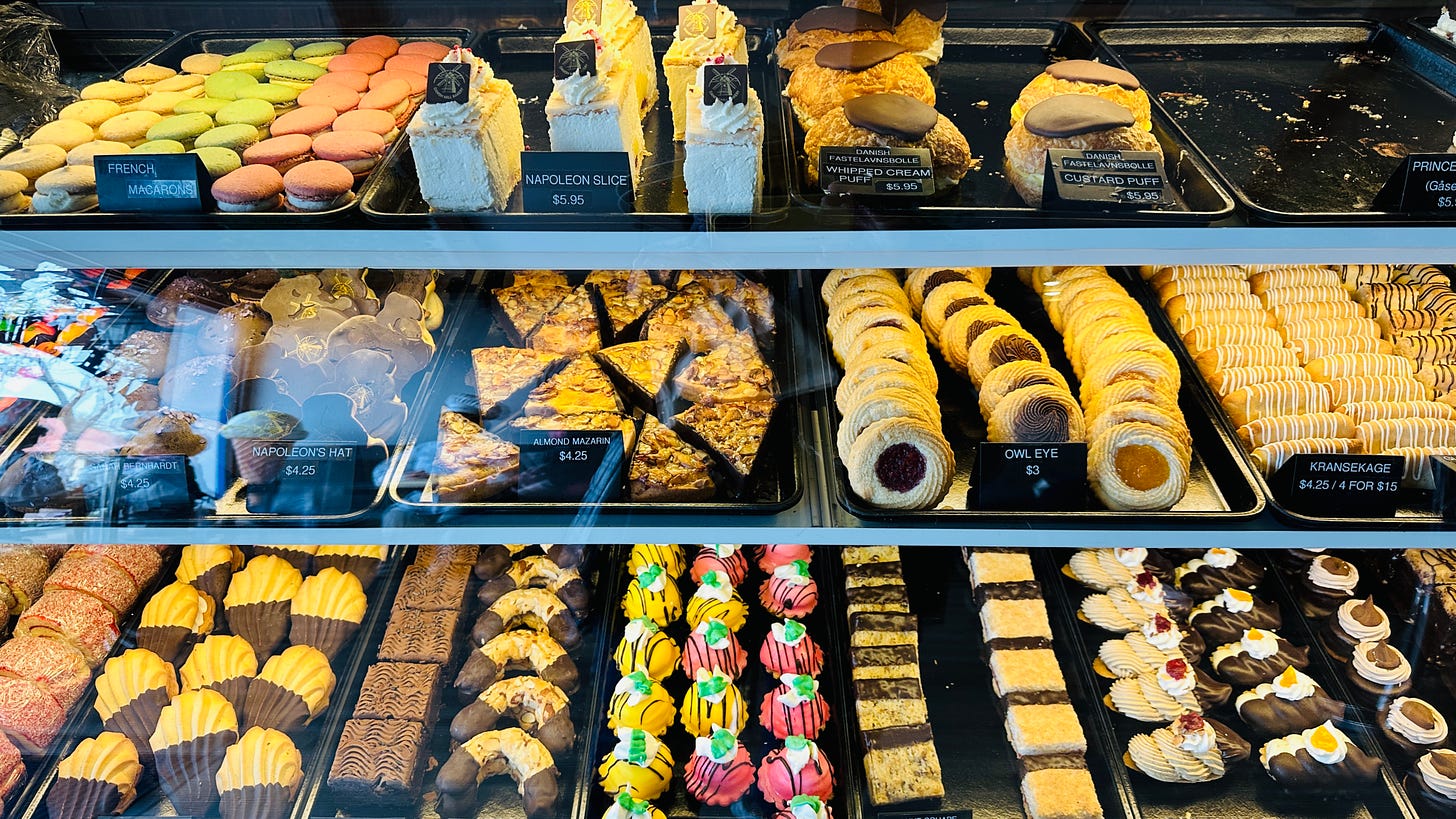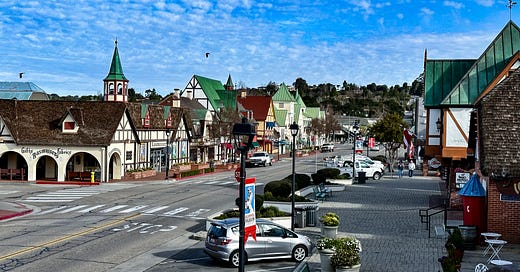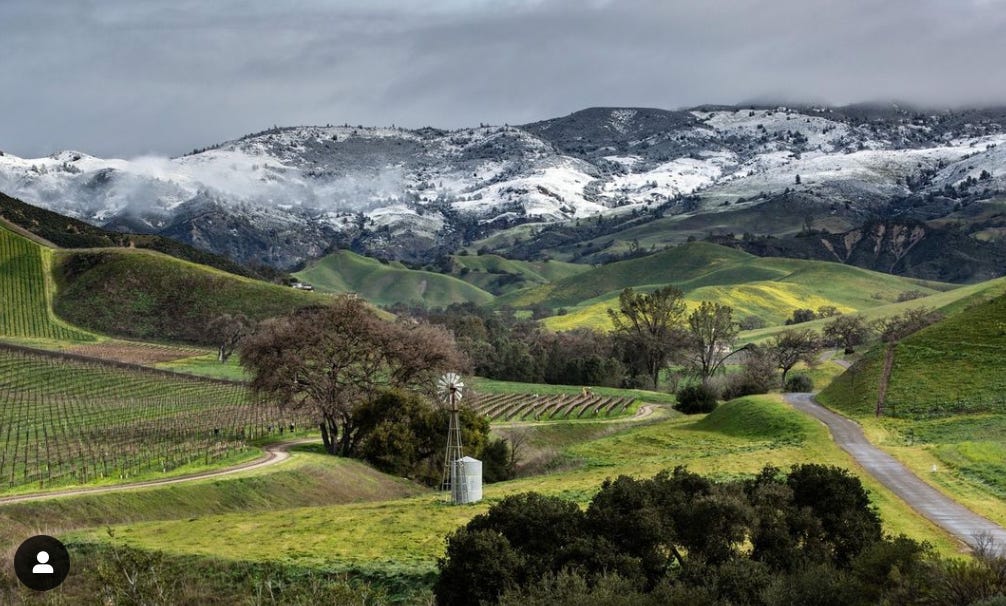Solvang: A Danish Village in California
Discovering old-world traditions and classic bakeries in a glorious spot
Years ago when my parents would drive from their home in the San Francisco Bay Area to visit us in Los Angeles, they would usually take a short detour off Highway 101 for an overnight stay at a small Danish-style village called Solvang, located about a half-hour north of Santa Barbara. They never talked much about the town they visited. It was just a convenient halfway stop en route to Southern California, something a younger me assumed aging parents did when road fatigue struck.

Earlier this month, we finally got around to visiting this little gem of a town and wondered what took us so long. I don’t say this because we now fall into the “aging parents” category. There’s really something here for everyone, not just those graying around the gills: Spectacular scenery both in town or outside for photographers like my husband Jeff; great food, particularly traditional Danish baked goods, for food geeks like me; museums on the town’s history and Danish culture, on famed Danish fairytale author Hans Christian Andersen, and on vintage motorcycles, among others; and the 214-year-old Mission Santa Inés, one of the original 21 California missions established by Franciscans along the Pacific Coast. For gamblers, there’s even a nearby casino owned and operated by the Santa Ynez Band of Chumash Mission Indians.

And, for wine lovers or the wine-curious, there are about 20 tasting places in Solvang and some 120 wineries in the surrounding Santa Ynez Valley area. It was actually a popular 2004 road film comedy/drama called Sideways that helped put the surrounding Santa Ynez Valley wine-growing region on the map and triggered increased tourism and wine consumption—particularly of pinot noir.
Our impetus to finally make the trip was an invitation from George Rose, a well-known photographer who once worked for the LA Times and USA Today and is now a resident of the area. George had agreed to be Jeff’s guide in pursuit of the best local photo spots for his PhotowalksTV YouTube show. Here’s a shot from George’s Instagram feed, taken along a country lane in Santa Ynez Valley last week during a rare storm that frosted the newly green hills with snow.
And here’s Jeff’s Photowalks TV episode about Solvang:
A little Solvang history
Along with a yen to try local pastry, I was interested in discovering more about the Danish heritage of Solvang, which dates back to its founding in 1911 by three Danish educators.
The town “really was founded by Danes for Danes,” Kirsten Klitgaard, a volunteer at the Solvang Visitor Center, told us.

The three men, Reverend Benedict Nordentoft, Reverend J. M. Gregersen, and Professor P. P. Hornsyld, initially settled in the Midwest, as many Danish immigrants did at that point. In search of a place where they could live the American dream but also hold onto their Danish culture and escape the harsh midwestern winters, they set their sights on the California coast. There, they bought about 9,000 acres at $40 an acre an area surrounding Old Mission Santa Inés. They named it Solvang, which means “Sunny Meadows.”

Many more Danish immigrants arrived over the years, along with non-Danes. By some accounts, only 10% of the Solvang population (6,126 as of the 2020 census) has Danish ancestry, but preserving the heritage of a town that has become a tourist magnet and is often referred to as “The Danish Capital of America” is a business that townsfolk like Kirsten take seriously.
You can see it not only in its half-timbered rural Danish-style architecture, four windmills and other signature buildings, but also in the multitude of restaurants and shops, many owned and operated with great pride by second-and third-generation descendants of the original residents.
Despite Solvang’s obvious charm, it doesn’t just exist as a showcase for tourists, Kirsten said.
“We’re not a Danish Disneyland,” Kirsten said. “We are a true organically Danish town.”
Many of the residents still have roots in the old country and take their children and grandchildren back to visit relatives there on a regular basis.
She encouraged us to visit the Elverhøj Museum of Art & History (pronounced “Elverhoy” in English), where she also volunteers, to learn more about the history of Solvang. The museum was built by hand—using recycled timbers and bricks and no nails—in the late ‘40s and early ‘50s by immigrant Danish sculptor and painter Viggo Brandt-Erichsen,1 with help from his artist wife Martha.
It was the Brandt-Erichsens’ home until 1988 when it was turned into a museum documenting the history of Solvang, celebrating Danish culture and the Danish-American immigrant experience and also promoting fine art and artists.
A wonderland of Danish pastry
Have you waded through all the details of my post so far just to get to the food?Well of course that’s my interest and passion too, particularly the baked goodies. There are lots of them in Solvang—and they have a stellar Danish pedigree too! The five town bakeries (six if you count a delightful fudge and pretzel shop), are mostly, if not all, founded, owned and operated by Danes and/or their second- and third-generation descendants who learned their craft from Danish-trained bakers. We wandered into several, of course, sampling a few pastries along the way—but how difficult it was to choose!

Each bakery has its own versions of popular Danish pastries, including possibly the most recognizable, kringles, traditionally a pretzel-shaped confections filled with almond paste, sometimes raisins and/or custard, usually topped with sliced nuts. There are also owl eyes, distinctive round cookies with jam centers (hence the name!), surrounded by a swirl of marzipan; and cream- and jam-filled Danish waffles made of sweet puff pastry, just to mention a few that set my mouth to watering.

And then there’s the ubiquitous Danish butter cookies with the distinctive round, rectangular and occasionally pretzel shapes, usually in a plastic tub or decorative tin stacked to catch the tourist's’ or local’s fancy on many a bakery shelf or shop window.
At Birkholm’s Bakery & Cafe, Thomas Birkholm, whose grandfather Carl “Cookie” Birkholm, Sr. started the business in 1951 using recipes he’d brought over from Denmark, joined his father, Carl, Jr. a few years ago in the bakery as a third-generation baker.
“I was born and raised in the bakery,” he told Santa Barbara’s KEYT News 3 a few years ago as he was making pastries at his father’s side. He took a few years off to be a firefighter, but came right back to the business afterwards.
A true Danish pastry, Carl, Sr. explains in the video, has to have 27 layers. “So it should be very light, very flaky, and not heavy.”
So what exactly is a Danish pastry? Often just called “a Danish,” it’s a variation of laminated pastry that’s created using layers of butter and dough—apparently 27 of them! Unlike regular puff pastry, it includes yeast, plus more butter (lots and lots!), sugar and other enrichments. These types of pastry are sometimes referred to as viennoiseries and include some of my favorite French pastries, like croissants and pain au chocolate.
According to a Wikipedia entry, Danish pastry was actually Austrian in origin and began when a strike in Denmark in 1850 that led Danish bakers to hire workers from abroad. Among them were some Austrians who brought with them their own traditions and recipes. The Danes then altered the recipes to suit their own tastes—and voila: the "Danish was born!
After enjoying a delicious grilled cheese sandwich made with Danish havarti cheese on brown bread, Jeff and I split a very flaky, buttery bear claw. It had an almond filling, as so many Danish pastries do, but I’ll just have to take the Birkholm family’s word on the 27 layers!
More Eats: Danish pancakes and Aebleskiver
One of our first stops when we arrived in town was Paula’s Pancake House, a 37-year-old landmark that our friend George Rose said was a must for anything breakfast (though the lunch menu looked pretty great too). Of course, what else could I order but Danish pancakes? These are thin, light and plate-sized, served as you see below with powdered sugar, fruit, and usually whipped cream. They were like cloud-like crepes that just melted in my mouth. Except for the butter and syrup, I could easily have convinced myself the calories had been removed!

One of the town’s specialties is something called aebleskiver (spelled æbleskiver in Danish). The name means apple slices, and, according to one theory, the original dish was probably made apple wedges fished out of a festive Christmas Gløgg (spiced wine), wrapped in dough and fried. Another origin story suggests aebleskiver were invented when a band of hungry Vikings attempted to make pancakes using their shields or helmets.
However they came to be, aebleskiver (the name is plural; singular is “aebleskive”) are more likely to include jam than apples and look more like fried doughnut holes than sliced fruit. They’re essentially little pancake balls cooked in a special pan, traditionally made on top of the stove in a cast iron, usually with seven round cavities for pouring in batter that you then cook until brown, turning carefully with two sticks or knitting needles (though I attempted it with one). Usually they’re filled with jam or anything you want—it could even be something savory—dusted with powdered sugar and served with additional jam on the side.
In Denmark they’re a popular snack, served during Christmas with Gløgg or sold by street vendors, usually three at a time.
By the time I began to notice the numerous menu offerings for aebleskiver— sometimes with ice cream on the side, along with the jam—our two-day stay in Solvang was coming to an end. At the Elverhøj Museum, I noticed that on the wood-fire stove in the vintage kitchen was a ancient cast-iron aebleskiver pan filled with mock aebleskiver balls. They looked pretty good for their age.
I was inspired to buy a pan, but opted for a nonstick aluminum model after finding the classic cast-iron version too heavy. The moment I purchased it, I thought it was probably a mistake to buy a single-purpose pan. My cupboards are already bursting. Where would I put it?
But a video demonstrating the many possible sweet and savory versions of aebleskiver revived my interest. And there are other dishes you can make, including a very popular Japanese treat called takoyaki, also a spherical snack that, like aebleskiver, is made from wheat flour and includes a filling—in this case a savory one of minced octopus. My son and daughter-in-law in Japan might be interested in that! (Maybe they’d even like a new pan!)
I played it safe and stuck to the sweet Danish version, following the recipe that came with the pan. It includes buttermilk, separated eggs and ricotta cheese. I’d be willing to bet you could sub cottage cheese for the ricotta, or possibly sour cream or yogurt. There are a number of alternatives to buttermilk as well.
As for the ableskiver pan, I haven’t come up with a hack for that. If you do, please let me know. Below is the recipe I used in case you’d like to give it a try. It did turn out pretty well on my second round of pancakes. On the first attempt, I overfilled the little divots and ended up burning the outside of the balls, while the interiors remained slightly undercooked. There’s definitely a bit of a learning curve, and, as usual, I didn’t follow the directions exactly when it came to quantities of batter and timing.
Here’s how it went:

And then the finished product (second time around):
And finally, plated!
If you got as far as the Aebleskiver recipe, congratulations!
I enjoyed the challenge of making these little snacks balls and want to try again with different fillings. There are quite a few creative ideas online. I found inspiration in Nordic Ware’s how-to video. Yes, it’s aim is to sell the company’s nonstick pan, but it does demonstrate some of the myriad ways you can have fun making and filling aebleskiver! If you decide to buy a pan, there are several versions available online—and I bet there are plenty of used ones from folks trying to clean out their overstocked shelves!
Just a note on where we stayed, as some folks have asked. It was the Corque Hotel, on Alisal Road, one of the main thoroughfares, and walking distance from almost everything you want to see, do and eat. There are plenty of other lodging choices as well. Here’s a link.
Okay, that’s it, folks. We packed in a hike or two and a wine tasting (with cupcakes!), but I’ll save that discussion for a future post. Meanwhile, there’s so much more that Jeff is able to show about the beauty and charm of Solvang in his latest Photowalks TV episode, so don’t forget to check it out. Here’s the link, or click on the YouTube video near the top of this post.
Thanks for reading, liking, commenting and, most of all, subscribing! Please come back soon for another edition of Ruth Talks Food!
Ruth
The excellent Elverhøj Museum bookstore carries a 2013 book about Brandt-Erichsen’s life called Four-Leafed Clover, written by his wife and son. I found a link to a fascinating document about his earlier life here.













Love this piece--glad you got in all the history.
Another wonderful article Ruth! I enjoyed reading it so much. What a fascinating place and those pancakes look wonderful.